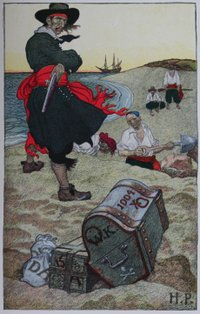
Pirate game
Encyclopedia

Game theory
Game theory is a mathematical method for analyzing calculated circumstances, such as in games, where a person’s success is based upon the choices of others...
. It illustrates how, if assumptions conforming to a homo economicus
Homo economicus
Homo economicus, or Economic human, is the concept in some economic theories of humans as rational and narrowly self-interested actors who have the ability to make judgments toward their subjectively defined ends...
model of human behaviour hold, outcomes may be surprising. It is a multi-player version of the ultimatum game
Ultimatum game
The ultimatum game is a game often played in economic experiments in which two players interact to decide how to divide a sum of money that is given to them. The first player proposes how to divide the sum between the two players, and the second player can either accept or reject this proposal. ...
.
The game
There are 5 rational pirates, A, B, C, D and E. They find 100 gold coins. They must decide how to distribute them.The pirates have a strict order of seniority: A is superior to B, who is superior to C, who is superior to D, who is superior to E.
The pirate world's rules of distribution are thus: that the most senior pirate should propose a distribution of coins. The pirates, including the proposer, then vote on whether to accept this distribution. If the proposed allocation is approved by a majority or a tie vote, it happens. If not, the proposer is thrown overboard from the pirate ship and dies, and the next most senior pirate makes a new proposal to begin the system again.
Pirates base their decisions on three factors. First of all, each pirate wants to survive. Second, given survival, each pirate wants to maximize the number of gold coins he receives. Third, each pirate would prefer to throw another overboard, if all other results would otherwise be equal.. The pirates do not trust each other, and will neither make nor honor any promises between pirates apart from the main proposal.
The result
It might be expected intuitively that Pirate A will have to allocate little if any to himself for fear of being voted off so that there are fewer pirates to share between. However, this is as far from the theoretical result as is possible.This is apparent if we work backwards: if all except D and E have been thrown overboard, D proposes 100 for himself and 0 for E. He has the casting vote, and so this is the allocation.
If there are three left (C, D and E) C knows that D will offer E 0 in the next round; therefore, C has to offer E 1 coin in this round to make E vote with him, and get his allocation through. Therefore, when only three are left the allocation is C:99, D:0, E:1.
If B, C, D and E remain, B knows this when he makes his decision. To avoid being thrown overboard, he can simply offer 1 to D. Because he has the casting vote, the support only by D is sufficient. Thus he proposes B:99, C:0, D:1, E:0. One might consider proposing B:99, C:0, D:0, E:1, as E knows he won't get more, if any, if he throws B overboard. But, as each pirate is eager to throw each other overboard, E would prefer to kill B, to get the same amount of gold from C.
Assuming A knows all these things, he can count on C and E's support for the following allocation, which is the final solution:
- A: 98 coins
- B: 0 coins
- C: 1 coin
- D: 0 coins
- E: 1 coin
Also, A:98, B:0, C:0, D:1, E:1 or other variants are not good enough, as D would rather throw A overboard to get the same amount of gold from B.
Extension
The solution follows the same general pattern for other numbers of pirates and/or coins, however the game changes in character when it is extended beyond there being twice as many pirates as there are coins. Ian StewartIan Stewart (mathematician)
Ian Nicholas Stewart FRS is a professor of mathematics at the University of Warwick, England, and a widely known popular-science and science-fiction writer. He is the first recipient of the , awarded jointly by the LMS and the IMA for his work on promoting mathematics.-Biography:Stewart was born...
wrote about Steve Omohundro's
Steve Omohundro
Steve Omohundro is an American scientist known for his research on Hamiltonian physics, dynamical systems, programming languages, machine learning, machine vision, and the social implications of artificial intelligence...
extension to an arbitrary number of pirates in the May 1999 edition of Scientific American
Scientific American
Scientific American is a popular science magazine. It is notable for its long history of presenting science monthly to an educated but not necessarily scientific public, through its careful attention to the clarity of its text as well as the quality of its specially commissioned color graphics...
and described the rather intricate pattern that emerges in the solution.

